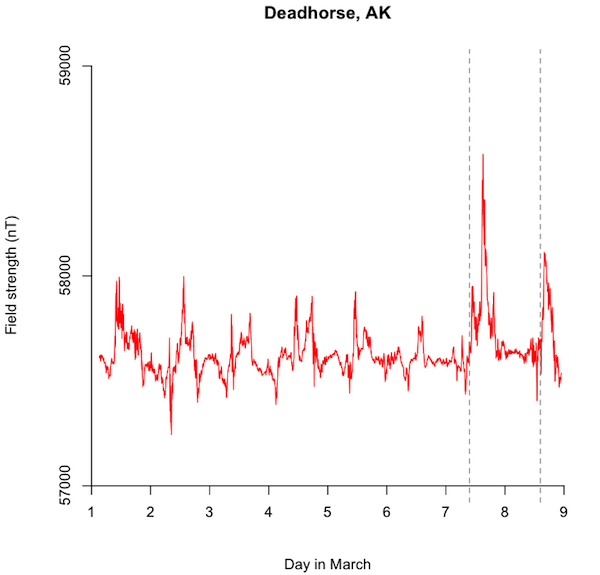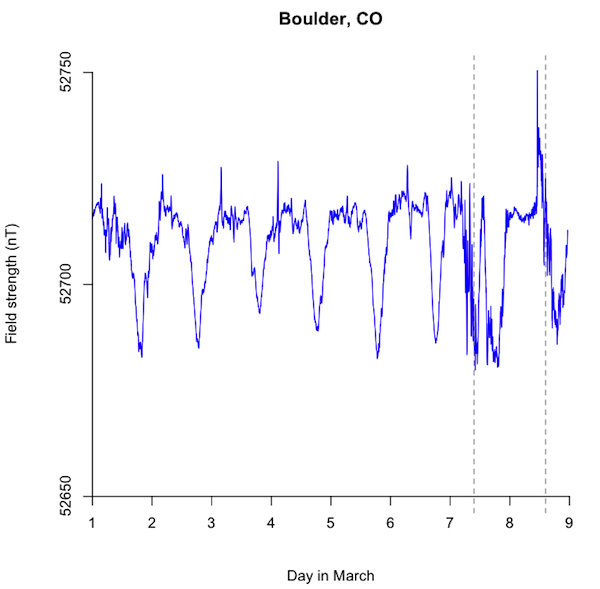![]() A couple of days ago, the sun got a bit excitable:
A couple of days ago, the sun got a bit excitable:
This large flare produced what is known as a Coronal Mass Ejection (CME), a blob of gas and radiation hurled at high velocities from the surface of the sun out into space, and which forecasts last night suggested was heading our way. This was potentially worrying, because when material from a CME impacts with the Earth’s magnetosphere it can cause a geomagnetic storm – powerful fluctuations in the local magnetic field that can not only damage orbiting satellites, but potentially induce crippling voltage fluctuations in our power grids.
The CME was forecast to pass through our planetary neighbourhood early this morning, so I was happy to wake to working electricity and internet. Still, I was curious about what effect the CME was having on the Earth’s magnetosphere, so I looked up some measurements from a couple of the USGS’s magnetic observatories. The figure below shows how the magnetic field strength in Deadhorse, Alaska – within the Arctic Circle – has varied since the beginning of March.

Geomagnetic field strength measured in Deadhorse, Alaska, in the first week of March. Data from the USGS.
Most of the magnetic field measured in Deadhorse or anywhere else on the Earth’s surface is being generated by convection in the Earth’s outer core. But this internal field will not vary too much over periods of days and weeks, so the fluctuations that we’re seeing on this plot must have an external cause. Mostly, they’re due to interactions of the magnetosphere – the part of the Earth’s magnetic field that extends beyond the atmosphere – with the solar wind. Bigger fluctuations correspond to a stronger, more energetic solar wind. The field before the 6th March appears has its fair share of jerks and fluctuations; Deadhorse is at a high latitude close to the north magnetic pole, where field lines run straight down from the magnetosphere into the inner core, so the solar wind has an especially strong influence here. However, there are two especially large jumps in the field on Wednesday and Thursday, marked roughly by the dotted vertical lines, which might be to the CME.
I also looked at data from the geomagnetic observatory in Boulder, Colorado.

Geomagnetic field strength measured in Boulder, Colorado, in the first week of March. Data from the USGS
We’re further from the pole, so the overall field in Boulder is a bit weaker. The external contribution to the ambient magnetic field still varies over the whole period I downloaded data for, but these fluctuations are both smaller than those observed at Deadhorse (20 or 30 nanoTeslas as opposed to more than 500 nT) and also more regular; there’s a definite day-night cycle caused by the the Earth’s rotation. This regular cycle is clearly interrupted on the 7th and 8th (yesterday and today), and the dotted lines show that these fluctuations at Boulder occurred at pretty much the same time as the largest jerks at Deadhorse do. This synchronous timing, seen in two places thousands of miles apart, tells us that this is a large-scale fluctuation of the magnetosphere, caused by it interacting with a large packet of unusually energetic solar wind.
So this latest CME did not pass our orbit completely quietly, even if it didn’t melt our power lines as it sped past. We can breathe a sigh of relief, and use our still functioning internets to go ‘ooh’ at the supercharged aurora.



Comments (1)
Links (1)-
Pingback: Now that’s what I call a geomagnetic storm! | Highly Allochthonous